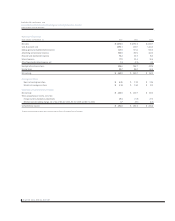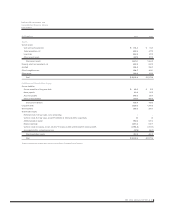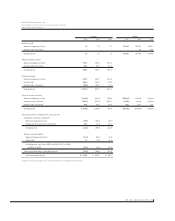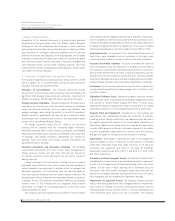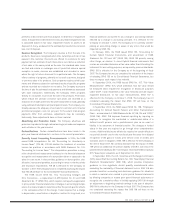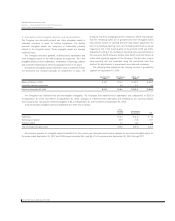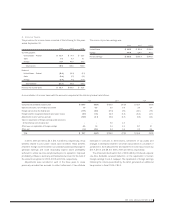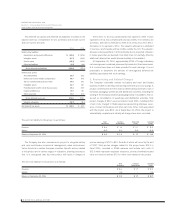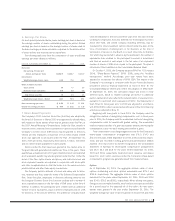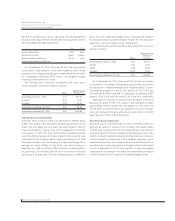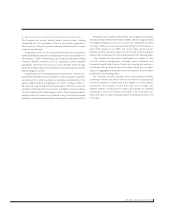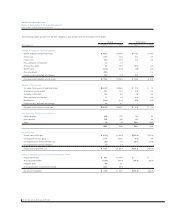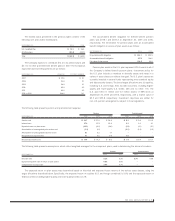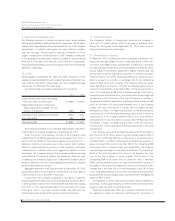Energizer 2006 Annual Report Download - page 29
Download and view the complete annual report
Please find page 29 of the 2006 Energizer annual report below. You can navigate through the pages in the report by either clicking on the pages listed below, or by using the keyword search tool below to find specific information within the annual report.
ENR 2006 ANNUAL REPORT 27
performs undiscounted cash flow analyses to determine if impairment
exists. If impairment is determined to exist, any related impairment loss
is calculated based on fair value. Impairment losses on assets to be
disposed of, if any, are based on the estimated proceeds to be received,
less cost of disposal.
Revenue Recognition The Company’s revenue is from the sale of its
products. Revenue is recognized when title, ownership and risk of loss
passes to the customer. Discounts are offered to customers for early
payment and an estimate of such discounts is recorded as a reduction
of net sales in the same period as the sale. Our standard sales terms
are final and returns or exchanges are not permitted unless a special
exception is made; reserves are established and recorded in cases
where the right of return does exist for a particular sale. The Company
offers a variety of programs, primarily to its retail customers, designed
to promote sales of its products. Such programs require periodic pay-
ments and allowances based on estimated results of specific programs
and are recorded as a reduction to net sales. The Company accrues at
the time of sale the estimated total payments and allowances associated
with each transaction. Additionally, the Company offers programs
directly to consumers to promote the sale of its products. Promotions
which reduce the ultimate consumer sale prices are recorded as a
reduction of net sales at the time the promotional offer is made, generally
using estimated redemption and participation levels. The Company con-
tinually assesses the adequacy of accruals for customer and consumer
promotional program costs not yet paid. To the extent total program
payments differ from estimates, adjustments may be necessary.
Historically, these adjustments have not been material.
Advertising and Promotion Costs The Company advertises and
promotes its products through national and regional media and expenses
such activities in the year incurred.
Reclassifications Certain reclassifications have been made to the
prior year financial statements to conform to the current presentation.
Recently Issued Accounting Pronouncements In 2006, the FASB
issued FASB Interpretation No. 48, “Accounting for Uncertainty in
Income Taxes” (FIN 48). FIN 48 clarifies the treatment of uncertain
income tax positions in accordance with FASB Statement No. 109,
“Accounting for Income Taxes.” The interpretation prescribes a recog-
nition threshold and measurement attribute for the financial statement
recognition and measurement of a tax position taken or expected to be
taken in a tax return. It also provides guidance on derecognition, clas-
sification, interest and penalties, accounting for taxes in interim periods
and disclosure requirements. FIN 48 is effective for the Company on
October 1, 2007. The Company has not completed assessing the impact
that FIN 48 will have on the Consolidated Financial Statements.
The FASB issued SFAS No. 154, “Accounting Changes and
Error Corrections – a replacement of APB Opinion No. 20 and FASB
Statement No. 3” (SFAS 154), which requires retrospective application
to prior periods’ financial statements of changes in accounting principle,
unless it is impracticable to determine either the period-specific effects
or the cumulative effect of the change. It also requires that a change
in depreciation, amortization or depletion method for long-lived, non-
financial assets be accounted for as a change in accounting estimate
effected by a change in accounting principle. It is effective for the
Company on October 1, 2006. The Company is not currently contem-
plating an accounting change or aware of any errors that would be
impacted by SFAS 154.
In February 2006, the FASB issued SFAS 155, “Accounting for
Certain Hybrid Financial Instruments, and amendment of FASB
Statement No. 133 and 140” (SFAS 155). SFAS 155 permits, among
other things, an election to record hybrid financial instruments that
contain an embedded derivative at fair value rather than bifurcating the
instrument for accounting purposes, as required by previous standards.
SFAS 155 is effective for the Company as of the beginning of fiscal
2007. The Company has not yet completed its evaluation of the impact
of adopting SFAS 155 on its Consolidated Financial Statements, but
does not expect such impact to be material.
In September 2006, the FASB issued SFAS No. 157, “Fair Value
Measurements” (SFAS 157), which addresses how fair value should
be measured when required for recognition or disclosure purposes
under GAAP. It also establishes a fair value hierarchy and will require
expanded disclosures on fair value measurements. SFAS 157 is
effective for the Company on October 1, 2008. The Company has not
completed assessing the impact that SFAS 157 will have on the
Consolidated Financial Statements.
In September 2006, the FASB issued SFAS No. 158, “Employers’
Accounting for Defined Benefit Pension and Other Postretirement
Plans – an amendment of FASB Statements No. 87, 88, 106 and 132(R)”
(SFAS 158). SFAS 158 improves financial reporting by requiring an
employer to recognize the overfunded or underfunded status of a
defined benefit pension and a postretirement plan as an asset or
liability in its statement of financial position. The changes in funded
status in that year are required to go through other comprehensive
income. Additional disclosure will also be required on certain effects on
net periodic benefit cost for the next fiscal year that arise from delayed
recognition of the gains or losses, prior service costs or credits, and
transition asset or obligation. SFAS 158 is effective for the Company at
the end of fiscal 2007. We currently estimate that the impact of SFAS
158 will be an additional net pension liability of $58.9, will reduce the
postretirement liability by $37.1 and impact total shareholders equity by
$17.7 based upon valuations as of September 30, 2006.
In September 2006, the U.S. Securities and Exchange Commission
(SEC) issued Staff Accounting Bulletin No. 108, “Quantifying Financial
Statement Misstatements” (SAB 108), which provides interpretive
guidance on how registrants should quantify misstatements when
evaluating the materiality of financial statement errors. SAB 108 also
provides transition accounting and disclosure guidance for situations
in which a material error existed in prior period financial statements
by allowing companies to restate prior period financial statements or
recognize the cumulative effect of initially applying SAB 108 through
an adjustment to beginning retained earnings in the year of adoption.
SAB 108 is effective for the Company in fiscal 2007. The Company has
not completed assessing the impact that SAB 108 will have on the
Consolidated Financial Statements.







